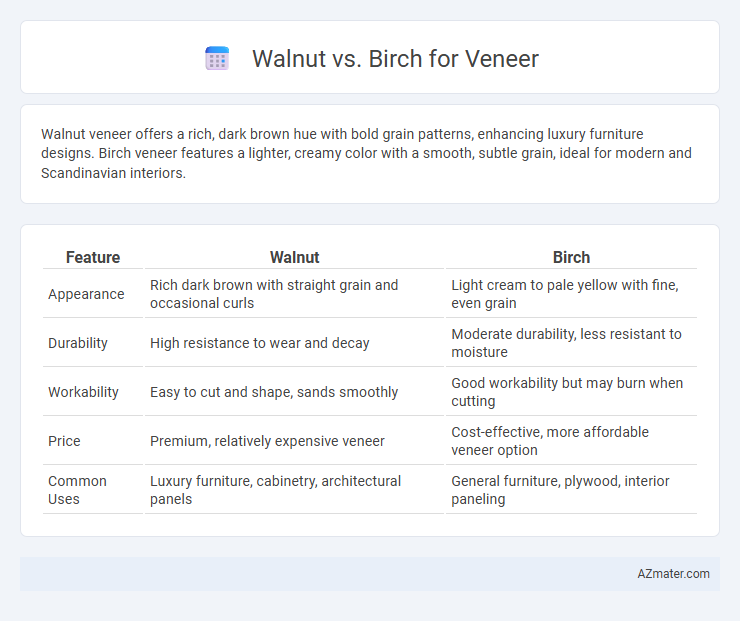Walnut veneer offers a rich, dark brown hue with bold grain patterns, enhancing luxury furniture designs. Birch veneer features a lighter, creamy color with a smooth, subtle grain, ideal for modern and Scandinavian interiors.
Table of Comparison
| Feature | Walnut | Birch |
|---|---|---|
| Appearance | Rich dark brown with straight grain and occasional curls | Light cream to pale yellow with fine, even grain |
| Durability | High resistance to wear and decay | Moderate durability, less resistant to moisture |
| Workability | Easy to cut and shape, sands smoothly | Good workability but may burn when cutting |
| Price | Premium, relatively expensive veneer | Cost-effective, more affordable veneer option |
| Common Uses | Luxury furniture, cabinetry, architectural panels | General furniture, plywood, interior paneling |
Introduction: Walnut vs Birch Veneer
Walnut veneer offers rich, dark brown tones with intricate grain patterns, making it a popular choice for high-end furniture and decorative surfaces. Birch veneer provides a lighter, more uniform appearance with a subtle grain, ideal for modern, minimalist designs and cost-effective applications. Both veneers deliver durable, smooth finishes but differ significantly in aesthetics and price points, influencing their selection based on project requirements.
Overview of Walnut Veneer
Walnut veneer is prized for its rich, dark brown tones with subtle purple and gray hues, creating a luxurious and warm aesthetic in furniture and cabinetry. Its fine, straight grain pattern combined with occasional swirling patterns adds depth and visual interest, making it a popular choice for high-end interior design. Walnut veneer also offers excellent durability and stability, ensuring longevity while maintaining its elegant appearance.
Overview of Birch Veneer
Birch veneer offers a light, creamy color with a fine, even grain, making it ideal for modern and Scandinavian-style furniture. It provides excellent durability and stability due to its hard, dense wood fibers, which resist warping and wear over time. Birch veneer is cost-effective compared to walnut, offering a versatile and attractive option for cabinetry, paneling, and decorative surfaces.
Appearance and Grain Patterns
Walnut veneer typically features rich, dark brown tones with deep, intricate grain patterns that provide a luxurious and warm aesthetic. Birch veneer presents a lighter, cream to pale yellow coloration with a fine, smooth grain that offers a clean and modern look. Both woods showcase distinct visual characteristics, with walnut's pronounced grain offering dramatic contrast and birch's subtle patterns favoring minimalist design.
Durability and Strength Comparison
Walnut veneer offers moderate durability with a Janka hardness rating around 1,010, making it suitable for decorative applications but less resistant to heavy wear compared to birch. Birch veneer, with a higher Janka hardness of approximately 1,260, provides greater strength and resilience, making it ideal for furniture and surfaces subject to frequent use. The denser grain structure of birch enhances its durability, while walnut's softer texture emphasizes aesthetic appeal over long-term toughness.
Workability and Machinability
Walnut veneer offers excellent workability due to its fine, straight grain and moderate density, allowing for smooth cutting and sanding without excessive tool wear. Birch veneer, known for its consistent texture and hardness, provides superior machinability, enabling precise shaping and minimal chipping during routing or milling. Both species respond well to staining and finishing, but walnut's softer nature typically demands less effort in machining processes, making it preferred for intricate detailing.
Cost and Availability
Walnut veneer typically commands a higher price due to its rich, dark grain and limited supply, making it less readily available than birch. Birch veneer offers a more budget-friendly option with wider availability, as it is harvested more abundantly and grows faster. Cost differences are influenced by regional supply chains, but birch generally remains the more economical choice for veneer applications.
Environmental Impact and Sustainability
Walnut veneer typically comes from slower-growing hardwood trees, resulting in longer harvesting cycles and potentially higher environmental impact compared to birch. Birch veneer is considered more sustainable due to its faster growth rate and widespread availability, making it a more renewable resource for wood production. Both materials require responsible sourcing and forest management to minimize ecological footprints and promote sustainability in veneer manufacturing.
Best Uses and Applications
Walnut veneer is prized for its rich, dark brown color and intricate grain patterns, making it ideal for high-end furniture, cabinetry, and decorative paneling where visual elegance is paramount. Birch veneer features a lighter, more uniform appearance with a fine grain, commonly used for contemporary cabinetry, drawer fronts, and interior doors requiring a clean, minimalist look. Both veneers provide excellent stability and workability, but walnut suits projects demanding a luxurious finish, while birch excels in modern applications that benefit from its subtle, consistent texture.
Choosing the Right Veneer for Your Project
Walnut veneer offers rich, dark tones with striking grain patterns ideal for luxurious and classic furniture designs, while birch veneer provides a lighter, more uniform appearance suited for modern, minimalist aesthetics. Choosing the right veneer involves considering the project's desired style, durability requirements, and the finished piece's exposure to wear or moisture. Walnut's robust hardness and deep hues enhance premium applications, whereas birch's smooth texture and flexibility make it versatile for both decorative and functional surfaces.

Infographic: Walnut vs Birch for Veneer
 azmater.com
azmater.com